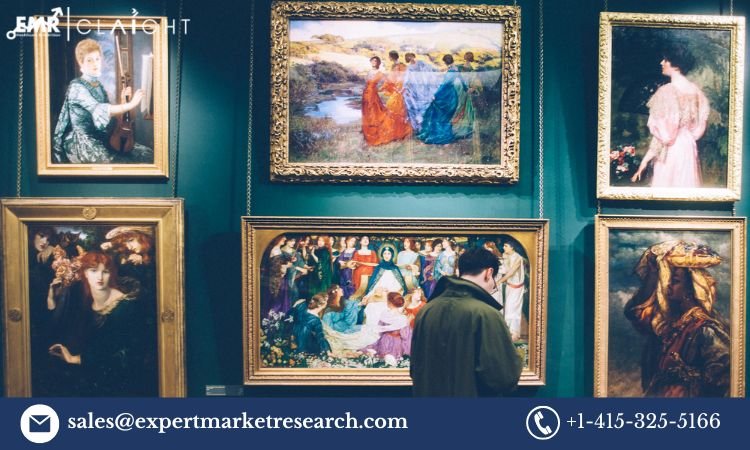The art market, valued at approximately USD 73.43 billion in 2024, represents one of the most intriguing and dynamic sectors of the global economy. With an estimated growth rate of 3.1% CAGR from 2025 to 2034, the market is projected to reach USD 97.22 billion by 2034. Art collectors, investors, and artists alike contribute to this vibrant market, which continues to evolve due to the rising interest in art as an investment, the digital revolution, and shifting consumer preferences.
This article explores the key factors influencing the global art market, including its size and share, market dynamics and trends, growth opportunities, and challenges. Additionally, we will examine the competitive landscape and the role of key players shaping the future of this expansive and diverse market.
Overview of the Art Market
The art market is a sector encompassing the buying, selling, and auctioning of artworks, including paintings, sculptures, photography, and digital art. It operates through various channels, including art galleries, auction houses, private sales, and online platforms. The market is driven by art collectors, investors, and enthusiasts who appreciate art for its aesthetic value, historical significance, and potential financial returns.
Over the years, the art market has witnessed significant transformations, particularly with the rise of online platforms and digital technologies, allowing artworks to reach a broader audience. Additionally, art investment has become a popular alternative to traditional investments, attracting high-net-worth individuals (HNWIs) and institutional investors. As a result, the global art market is growing, with key regions such as North America, Europe, and Asia driving much of the market’s value.
The market’s dynamics are influenced by a variety of factors, including economic conditions, cultural shifts, changes in consumer behavior, and technological advancements. The art world’s embrace of new technologies, including blockchain for provenance tracking and NFTs (Non-Fungible Tokens) for digital art, has brought both opportunities and challenges.
Art Market Size & Share
In 2024, the global art market reached a market size of USD 73.43 billion, marking significant growth driven by robust demand across all regions and art sectors. Over the forecast period from 2025 to 2034, the art market is expected to grow at a CAGR of 3.1%, reaching a projected value of USD 97.22 billion by 2034. This growth is attributed to several factors, including the increasing interest in art as an alternative investment and the ongoing digitalization of the market.
Market Share Breakdown:
- Traditional Art Sales: Traditional artworks, including paintings, sculptures, and antiques, still dominate the market share, particularly in high-end auctions and galleries. These assets continue to attract affluent collectors and investors, contributing significantly to the overall market value.
- Digital Art & NFTs: The emergence of digital art and NFTs has revolutionized the art market, attracting younger generations and tech-savvy investors. This segment has experienced explosive growth, offering new opportunities for artists to monetize their work and buyers to invest in digital assets.
- Art Auction Houses: Auction houses such as Sotheby’s, Christie’s, and Phillips play a critical role in facilitating high-value art sales. These institutions are key players in the art market, regularly setting world records for art transactions.
Regional Market Share:
- North America: North America, particularly the U.S., holds a significant share of the global art market, with many of the world’s most prominent art auction houses and galleries located in major cities such as New York. The region remains a dominant force in the global art scene.
- Europe: Europe, home to some of the oldest art traditions, continues to be a major player in the art market. The U.K., France, and Switzerland are important art hubs, with many top-tier art fairs and auctions taking place across the continent.
- Asia-Pacific: The Asia-Pacific region is seeing rapid growth in its art market, particularly in China, where art collectors are increasingly seeking Western art and collectibles. Hong Kong has also become a major art auction destination, drawing buyers from across the globe.
Art Market Dynamics & Trends
The art market is heavily influenced by a variety of internal and external factors. In recent years, several trends have emerged that are shaping the current and future landscape of the market. From evolving consumer preferences to technological advancements, these dynamics are creating new opportunities and challenges for market participants.
Key Market Dynamics:
- Art as an Investment: One of the most significant drivers of the art market is the increasing interest in art as an investment asset. High-net-worth individuals (HNWIs) and institutional investors are increasingly viewing art as a stable, long-term investment, with potential for high returns. As a result, auction houses and galleries are experiencing an influx of art sales, particularly in the high-end segment.
- Digital Transformation: The rise of digital platforms has made art more accessible to a global audience. Online auctions, virtual galleries, and the sale of NFTs have introduced new ways for buyers and sellers to interact. This digital transformation is particularly evident in the sale of contemporary art, where new technologies are reshaping the way art is created, sold, and traded.
- Diversity and Inclusion: Another key trend in the art market is the growing emphasis on diversity and inclusion. Galleries and collectors are increasingly seeking to highlight the works of underrepresented artists, including women, artists of color, and those from marginalized communities. This shift is contributing to the broadening of the art market and introducing new perspectives.
- Sustainability and Ethical Practices: As consumers become more conscious of environmental and ethical concerns, there is a growing demand for sustainable and ethically produced art. Artists and institutions are responding by adopting environmentally friendly practices, such as using recycled materials and supporting fair trade initiatives.
Get a Free Sample Report with a Table of Contents:
https://www.expertmarketresearch.com/reports/Art-Market/requestsample
Growth of the Art Market
The global art market is set for steady growth in the coming decade, with a projected CAGR of 3.1% between 2025 and 2034. This growth is primarily driven by the increasing number of art collectors, the rising interest in art investment, and the expansion of digital platforms that make art more accessible.
Key Growth Drivers:
- Increased Investment in Art: Art investment is becoming an attractive alternative to traditional financial instruments like stocks and bonds. The potential for art to appreciate in value over time, coupled with the increasing availability of investment-grade artworks, has contributed to market growth. The art market’s resilience during economic downturns also makes it an appealing choice for investors.
- Expansion of Digital Platforms: The growth of online art sales is another key factor in the market’s expansion. Digital platforms, including auction houses and online marketplaces, are making it easier for buyers to access artworks from around the world. As the digital transformation continues, more artists are embracing online channels to sell their works, expanding their reach and attracting new buyers.
- Rising Affluence in Emerging Markets: The art market is also benefiting from the growing wealth of consumers in emerging markets, particularly in Asia. As disposable incomes rise, more people in countries such as China and India are turning to art as both a cultural and financial investment.
- Globalization of the Art Scene: Global art fairs, auctions, and exhibitions are bringing together collectors, investors, and artists from around the world. This globalized art scene is fueling demand for both contemporary and classic works of art, further contributing to the growth of the market.
Market Opportunities and Challenges
While the art market presents many exciting opportunities, it is not without its challenges. Understanding these opportunities and challenges is crucial for stakeholders who wish to capitalize on the growing demand for art.
Opportunities:
- Expansion in Emerging Markets: The art market has significant potential for growth in emerging markets such as China, India, and Latin America. As these regions experience economic development and increasing affluence, demand for art is expected to rise, opening up new opportunities for artists, galleries, and investors.
- Digital Art and NFTs: The rise of digital art and NFTs presents an exciting opportunity for artists and collectors. NFTs allow artists to monetize their digital works in new ways, while buyers gain the ability to own verifiable digital assets. This segment of the art market is expected to grow rapidly in the coming years, offering new revenue streams for artists and platforms.
- Sustainability and Ethical Practices: There is an increasing demand for sustainable and ethically produced art. Artists and institutions that embrace eco-friendly practices and ethical sourcing will benefit from this shift, as consumers are becoming more aware of the environmental and social impact of their purchases.
- Art Investment Platforms: The rise of online investment platforms that allow individuals to invest in high-value artworks is a growing opportunity. These platforms democratize access to the art market, enabling a wider range of investors to participate.
Challenges:
- Market Volatility: The art market can be subject to volatility, with fluctuations in prices driven by economic conditions, market sentiment, and individual artist reputations. This unpredictability can create challenges for investors seeking stable returns.
- Counterfeit Artworks and Provenance Issues: Art buyers face the risk of purchasing counterfeit or misrepresented artworks. The lack of standardized provenance tracking can complicate the verification process. However, technological advancements like blockchain are being introduced to address these issues.
- High Transaction Costs: The costs associated with buying and selling art, including auction fees, commissions, and insurance, can be significant. These high transaction costs may deter some potential buyers and sellers from participating in the market.
- Cultural and Regulatory Barriers: Different regions and countries have varying cultural and regulatory standards when it comes to art transactions. Navigating these differences can be challenging for international buyers and sellers, particularly as art crosses borders for exhibitions and sales.
Competitor Analysis: Key Players in the Art Market
Several leading companies dominate the global art market, including traditional auction houses, galleries, and digital platforms. Below are brief profiles of some of the most prominent players in the industry:
- Sotheby’s: Sotheby’s is one of the world’s most renowned auction houses, specializing in fine art, jewelry, and collectibles. Known for its high-profile auctions, Sotheby’s remains a key player in the art market, consistently setting records for art sales.
- Christie’s: Christie’s is another leading auction house, with a long history of handling high-value art transactions. The company has a strong presence in both traditional and digital art auctions, continually innovating with new sales formats.
- Art Basel: Art Basel is one of the largest and most prestigious contemporary art fairs globally. The event attracts galleries, collectors, and artists from around the world, making it a vital platform for showcasing new art trends and emerging talent.
- Artnet: Artnet is an online marketplace and information platform for the global art market. With its extensive database of auction results, it is a valuable resource for art collectors and investors seeking transparency and insight into market trends.
- OpenSea: OpenSea is one of the largest online NFT marketplaces, facilitating the buying and selling of digital art and collectibles. As the NFT market continues to grow, OpenSea plays a central role in connecting digital artists with collectors.
Explore our trending Blogs and Reports :
Honey Market
HVAC Variable Frequency Drive Market






Leave a Reply